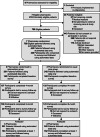Naloxone Co-Dispensing with Opioids: a Cluster Randomized Pragmatic Trial
- PMID: 35132556
- PMCID: PMC9411391
- DOI: 10.1007/s11606-021-07356-6
Naloxone Co-Dispensing with Opioids: a Cluster Randomized Pragmatic Trial
Abstract
Background: Although naloxone prevents opioid overdose deaths, few patients prescribed opioids receive naloxone, limiting its effectiveness in real-world settings. Barriers to naloxone prescribing include concerns that naloxone could increase risk behavior and limited time to provide necessary patient education.
Objective: To determine whether pharmacy-based naloxone co-dispensing affected opioid risk behavior. Secondary objectives were to assess if co-dispensing increased naloxone acquisition, increased patient knowledge about naloxone administration, and affected opioid dose and other substance use.
Design: Cluster randomized pragmatic trial of naloxone co-dispensing.
Setting: Safety-net health system in Denver, Colorado, between 2017 and 2020.
Participants: Seven pharmacies were randomized. Pharmacy patients (N=768) receiving opioids were followed using automated data for 10 months. Pharmacy patients were also invited to complete surveys at baseline, 4 months, and 8 months; 325 survey participants were enrolled from November 15, 2017, to January 8, 2019.
Intervention: Intervention pharmacies implemented workflows to co-dispense naloxone while usual care pharmacies provided usual services.
Main measures: Survey instruments assessed opioid risk behavior; hazardous drinking; tobacco, cannabis, and other drug use; and knowledge. Naloxone dispensings and opioid dose were evaluated using pharmacy data among pharmacy patients and survey participants. Intention-to-treat analyses were conducted using generalized linear mixed models accounting for clustering at the pharmacy level.
Key results: Opioid risk behavior did not differ by trial group (P=0.52; 8-month vs. baseline adjusted risk ratio [ARR] 1.07; 95% CI 0.78, 1.47). Compared with usual care pharmacies, naloxone dispensings were higher in intervention pharmacies (ARR 3.38; 95% CI 2.21, 5.15) and participant knowledge increased (P=0.02; 8-month vs. baseline adjusted mean difference 1.05; 95% CI 0.06, 2.04). There was no difference in other substance use by the trial group.
Conclusion: Co-dispensing naloxone with opioids effectively increased naloxone receipt and knowledge but did not increase self-reported risk behavior.
Trial registration: Registered at ClinicalTrials.gov ; Identifier: NCT03337100.
Keywords: naloxone; overdose; prescription opioids; risk compensation; substance use.
© 2022. The Author(s) under exclusive licence to Society of General Internal Medicine.
Conflict of interest statement
Outside of the listed affiliations, I.B. reports royalties from UpToDate, and all remaining authors declare that they do not have a conflict of interest.
Figures
Comment in
-
Time for Pharmacy Co-dispensing of Naloxone with Prescribed Opioids?J Gen Intern Med. 2022 Aug;37(11):2621-2623. doi: 10.1007/s11606-022-07643-w. J Gen Intern Med. 2022. PMID: 35581455 Free PMC article. No abstract available.
References
-
- U.S. Department of Health and Human Services. HHS recommends prescribing or co-prescribing naloxone to patients at high risk for an opioid overdose. HHS.Gov. December 19, 2018. https://www.hhs.gov/about/news/2018/12/19/hhs-recommends-prescribing-or-.... Accessed 29 Sep 2021.
Publication types
MeSH terms
Substances
Associated data
Grants and funding
LinkOut - more resources
Full Text Sources
Medical


